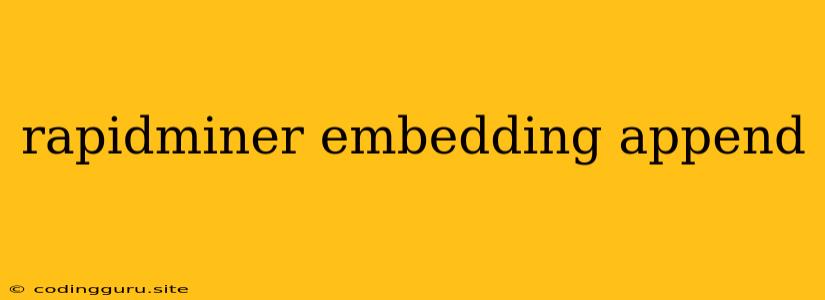RapidMiner: Embedding and Appending Data for Powerful Analysis
RapidMiner is a powerful data science platform that offers a wide range of tools for data preparation, modeling, and evaluation. One of the key features of RapidMiner is its ability to handle various data formats and perform complex data manipulation tasks. This article will focus on two essential techniques: embedding and appending data, which are crucial for enhancing the quality and usability of your datasets in RapidMiner.
What is Data Embedding?
Embedding in RapidMiner refers to the process of transforming categorical variables into numerical representations. This is essential because many machine learning algorithms require numerical input. Categorical variables, which represent qualitative data like colors, genders, or categories, cannot be directly used in these algorithms.
Why is embedding important?
- Compatibility with algorithms: Embedding allows categorical variables to be used in algorithms that require numerical input.
- Improved performance: By transforming categorical data into numerical representations, embedding can improve the performance of machine learning algorithms.
- Better interpretation: Embedding helps in interpreting the results of models, as the numerical representation of categorical variables provides a clearer understanding of the data.
How to embed data in RapidMiner:
RapidMiner offers several operators for embedding data, including:
- Nominal to Numerical: This operator converts categorical variables into numerical values using a variety of encoding methods.
- One-Hot Encoding: This operator creates binary features for each category, indicating whether or not a specific category is present.
- Target Encoding: This operator calculates the average target value for each category and uses it as the numerical representation.
What is Data Appending?
Appending data in RapidMiner is the process of combining multiple datasets into a single dataset. This can be done by adding rows (vertical append) or columns (horizontal append) to an existing dataset.
Why is appending important?
- Creating a comprehensive dataset: Appending allows you to combine data from different sources into a single dataset for comprehensive analysis.
- Improving data richness: By appending datasets with complementary information, you can enrich the existing data and create more meaningful insights.
- Facilitating analysis: Appending datasets can simplify analysis, as you are working with a single dataset instead of multiple datasets.
How to append data in RapidMiner:
RapidMiner provides several operators for appending data:
- Append: This operator combines data from multiple datasets by adding rows or columns.
- Join: This operator combines data from multiple datasets based on a common key.
- Merge: This operator combines data from multiple datasets based on a common key, but with the ability to specify how to handle duplicate values.
Combining Embedding and Appending: A Practical Example
Let's imagine you are building a model to predict customer churn. You have two datasets: one containing customer demographics and the other containing their transaction history. Here's how you can combine embedding and appending to create a powerful dataset:
- Embed categorical variables: You might have categorical variables like "gender," "age group," and "location" in the demographics dataset. Use the Nominal to Numerical operator to embed these variables.
- Append datasets: After embedding, append the two datasets using the Append operator.
- Further analysis: With the combined dataset, you can now use this enriched data to train and evaluate your customer churn prediction model.
Benefits of Using Embedding and Appending in RapidMiner
- Improved data quality: Embedding and appending allow you to prepare high-quality data for analysis.
- More accurate models: By working with well-prepared data, you can develop more accurate machine learning models.
- Increased efficiency: These techniques streamline data preparation and simplify analysis, leading to increased efficiency in your workflow.
Conclusion
Embedding and appending are powerful techniques in RapidMiner that allow you to transform and combine data effectively. By understanding and implementing these techniques, you can enhance the quality and usability of your datasets, ultimately leading to more powerful and insightful analyses. RapidMiner's user-friendly interface and comprehensive set of operators make these tasks straightforward, even for beginners.
